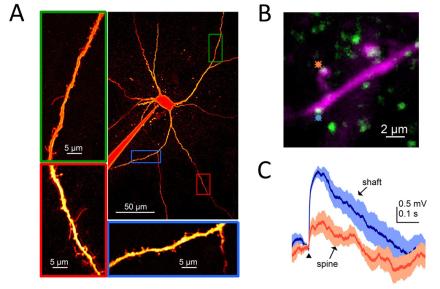
Zayd Khaliq, Ph.D.
Tenure Track Investigator at NINDS/NIH
Chief of the Cellular Neurophysiology Unit
Making a career at the frontiers of human knowledge
I became interested in science early in life through conversations with my father. He was not a scientist, doctor, or engineer; he worked as a corrections officer in New York City. But he was fascinated with the universe and loved discussing the possibilities of time travel, black holes, and alternate universes. Talking with him, I realized that science was a place that your imagination could roam free and that almost anything was possible if you have the creativity and will to make it happen.
Likely primed by my father’s interest in astronomy, I studied physics at Dartmouth College and continued on as a technician in an atomic physics lab at New York University for a period after graduation. While I enjoyed my time in physics, I started to become aware of the excitement and opportunities in the rapidly progressing field of neuroscience. Following a move to Iowa, I applied to an opening in a neuroscience lab run by Dr. Alan Kay and had the good fortune of being offered the position.
My time in Dr. Kay’s lab was a critical experience for me because it was there that I discovered my love of neurophysiology. As a postbaccalaureate in his lab, I functioned as an independent scientist for the first time and was allowed to run my own experiments. Furthermore, I found that my physics training was helpful both for understanding electrophysiological questions as well as for the practical maintenance of my experimental setup. I learned that neuroscience was a perfect fit for me and I never turned back.
For my graduate work at Northwestern University, I joined the laboratory of Dr. Indira Raman who studies cellular excitability of neurons in the cerebellum. I found excitement discussing experiments with Dr. Raman and was thrilled to perform these experiments, many days working late into the evening. Most of all, I learned from Dr. Raman that my father was right—many of the best scientists approached their study from a standpoint of creativity and imagination. More importantly, however, I learned that I can also have fun designing experiments that rigorously test those ideas. So in the end, true scientific progress has to involve both creativity and rigor.
During graduate school, I was awarded a Predoctoral NRSA Fellowship (F31). This fellowship was important because I felt like I was full participant in the scientific endeavor. Writing the application forced me to clarify my goals and expectations of my research plan, which was on the reliability of action potential propagation in the axons of Purkinje neurons. The project was very technically difficult, and taught me how to deal with failure and turn it into a motivating factor to keep trying for success. Towards the end of graduate school, I was also selected to participate in the Society for Neuroscience's Neuroscience Scholars Program (NSP), funded by NINDS. This program was a fantastic opportunity for me and was critical for helping me to expand my scientific network. In fact, several of the scientists that I met through NSP remain close colleagues to this very day.
After graduate school, I continued to study cellular neurophysiology with Dr. Bruce Bean at Harvard Medical School. I chose Dr. Bean’s lab because his papers contained a level of analysis that appealed to me, pushing deeply into topics to reveal important insights. As learned when I arrived, Dr. Bean also turned out to be a gifted mentor, and I try to apply everything that I have learned from him and Dr. Raman in my own lab.
During the fourth year of my postdoc, I started applying to faculty positions, including at NIH. The application and interview process for the Intramural Research Program at NIH was similar to academic positions. Applicants are expected to define the research direction, future aims, give a lecture and chalk talk, and meet with other investigators. When I got the job offer, I was filled with excitement. The advantage of working at the NIH intramural program is that it is a huge institution with experts in every imaginable topic in biomedicine. This environment makes it easier to take on projects outside of your expertise as it is likely that someone here has the knowledge, skills, or equipment to help you.
The one question I am constantly asked is, “What’s it like not to have to apply for grants?” While it is true that intramural investigators do not apply for R01s, our scientific progress is evaluated every 3-4 years at meetings with the Board of Scientific Counselors, a group of extramural scientists charged with scientific oversight for NIH investigators. This entails writing up a progress report, defining future plans (equivalent to an R01 grant), and giving a presentation to defend those plans. The board provides recommendations that are used to determine funding levels, staffing, and promotions. In addition, we still must compete for tenure in a process that is comparable to principal investigators at extramural institutions.
Although the process of discovery can be difficult, I feel privileged to be working as scientific investigator. As scientists, we are given an opportunity to travel out to the fringes of human knowledge and hopefully learn something that will change how people think about the world around us. It is a tremendous opportunity, and one that I would not trade for comfort in any other career.
Current Research

Dopamine-releasing neurons located in the midbrain play a key role in motivation, movement, and reward behaviors. Reward-relevant information is encoded in high-frequency bursts of action potentials that trigger the release of dopamine and facilitate motor learning. The long-term goal of our work is to understand the subcellular, cellular, and circuit level principles that enable midbrain dopamine neurons to compute reward prediction errors and other behaviorally-relevant signals. Our overall research efforts focus on determining how synaptic inputs are integrated in spines, dendrites, and soma of dopamine neurons.
Dopaminergic neurons have commonly been categorized as aspiny neurons. In recent work, however, we used two-photon uncaging of glutamate with imaging in a mouse line that expresses fluorescently tagged-PSD95 to locate glutamatergic synapses on the dendrites of these cells (Hage et al., 2016). Indeed, we found that dopamine neurons express functional spines (A) and that the size of synaptic EPSPs correlated positively with the presence of PSD-95 (green) but were substantially larger in with activation of shaft synapses (B, C). Asterisks indicate sites of glutamate uncaging on a PSD-95 positive spine (orange) and shaft (blue) synapses.
